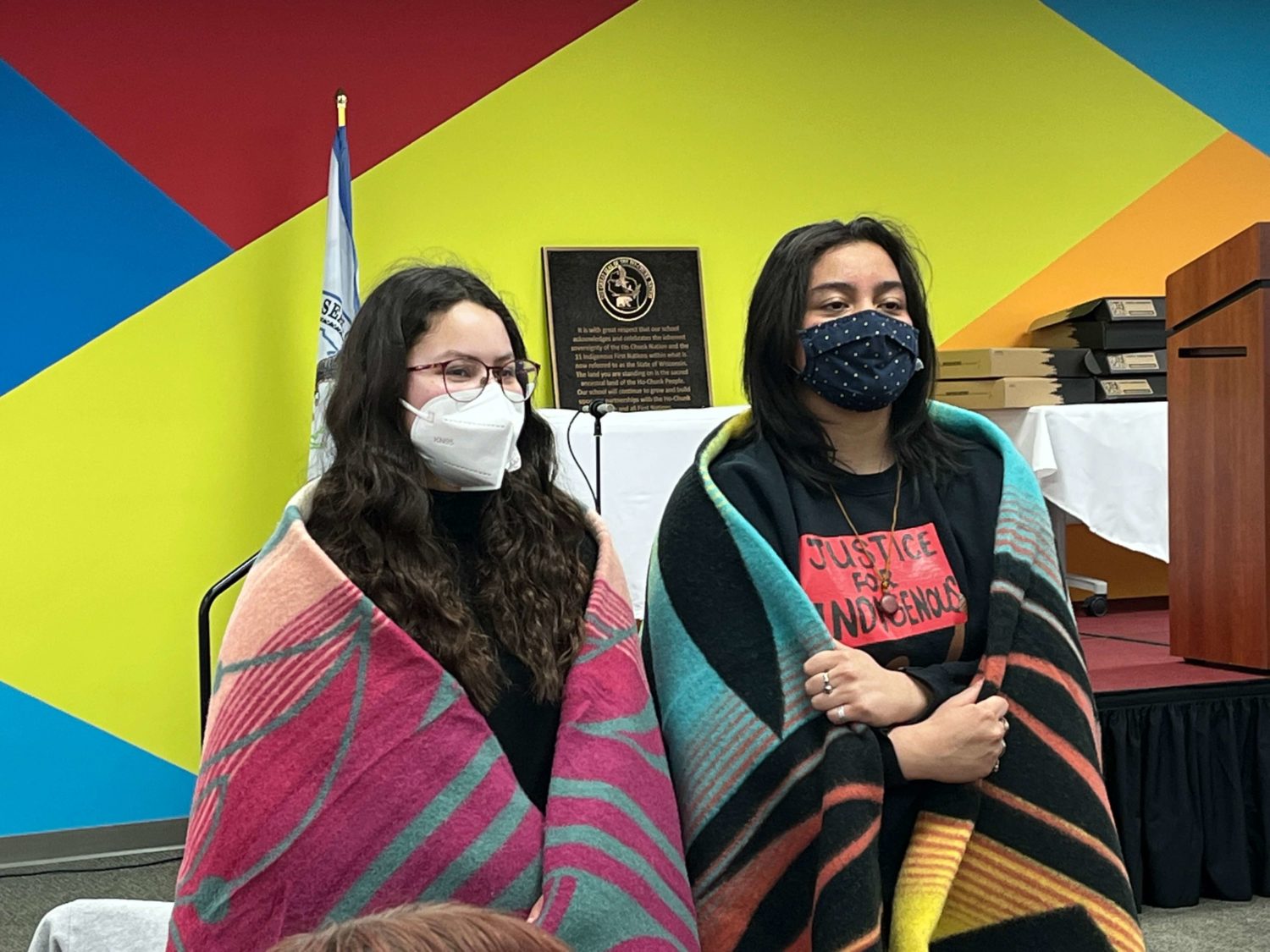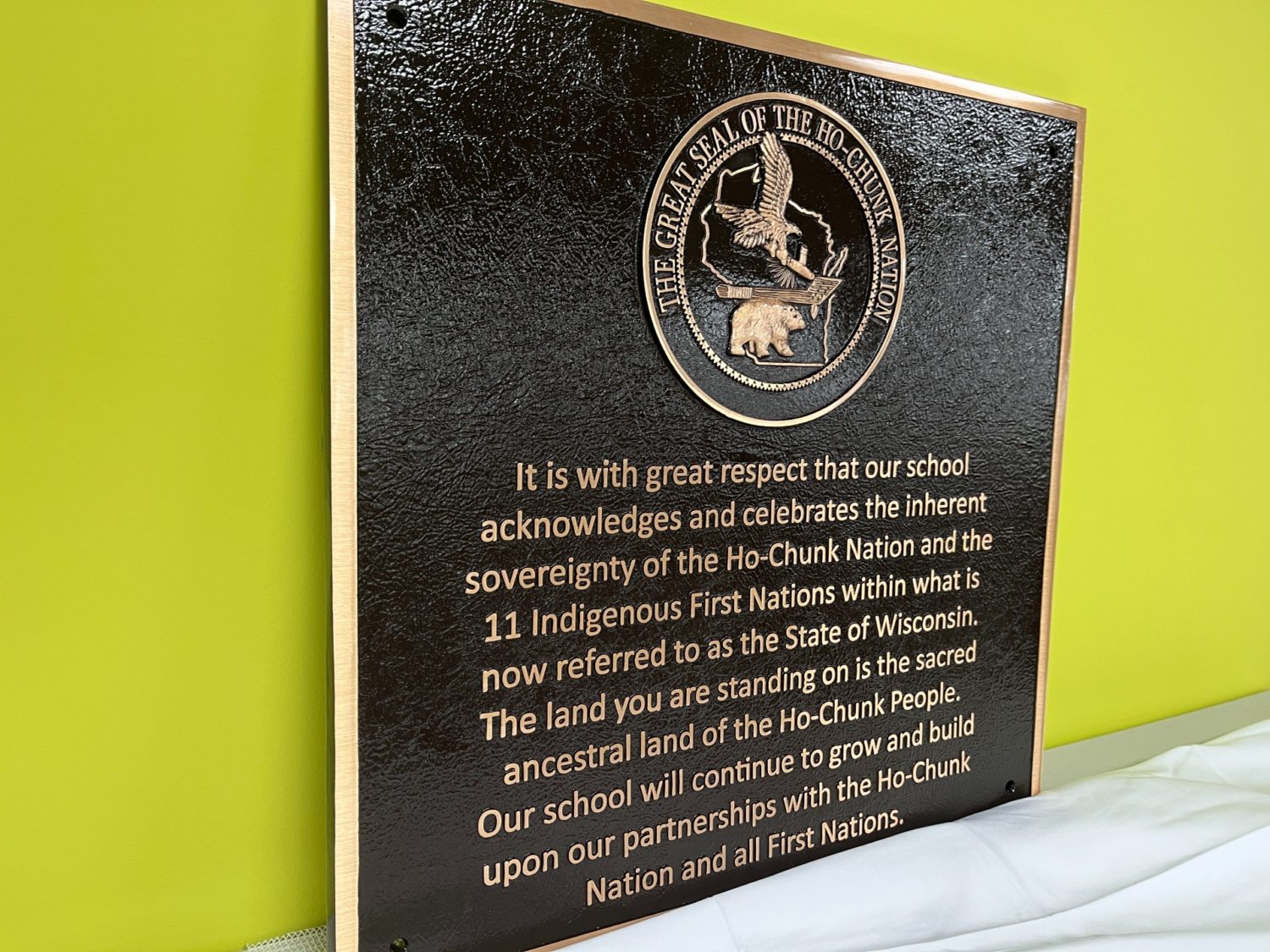
Over the next three years, all Madison schools will have plaques installed acknowledging that the land on which they stand is “the sacred ancestral land of the Ho-Chunk People” and pledging to “grow and build upon our partnerships with the Ho-Chunk Nation and all First Nations.”
The project was announced at a ceremony attended by about 150 school district officials and students, Ho-Chunk elders and other community members. It’s the culmination of nearly three years of work by members of the Native American Student Associations (NASA) and Madison West and Madison East High Schools.
Isa Saiz, a member of the Ponca Tribe, and Marena Fox Baker, a member of the Colville Confederated Tribes, were just freshmen at West and East, respectively, when they and other students were inspired by a land acknowledgement at the University of Wisconsin.
“They came to us, the parents, and said, you know, we’d like to just do land acknowledgment out at East and West and get a plaque put up there. And we actually started fundraising, just doing cookie sales and stuff like that,” said Sean Saiz, a longtime Madison resident and father of Isa.

When Madison Metropolitan School District announced the hiring of Dr. Carlton Jenkins as the new superintendent in 2020, though, he met with various community groups, including the Indigenous community. Saiz and Fox Baker both recall him embracing the idea, and actually encouraging them to “go big,” beyond the two high schools. In 2021, the school board unanimously approved $90,000 for more than 50 plaques.
“We are all here today because Indigenous students in our community wanted to feel safe, seen and acknowledged,” Fox Baker said in remarks to the assembled crowd. “Throughout my time in the district, I saw little to no representation of Indigenous people in my schools. The art on the walls did not reflect us, nor the curriculum that was taught.”
That’s why many speakers said the plaques are only a first step.
“This project is much more than the plaques themselves,” Fox Baker said. “To us, they represent the commitment that MMSD is making, and a step toward being acknowledged in our community. MMSD is committed to indigenizing curriculum, bringing awareness to indigenous history, as well as indigenous presence today, and providing professional development for teachers.”
“I really just want to see changes in the curriculum. Again, this is a first step,” said Isa Saiz, noting that some Indigenous nations are still referred to in classes and textbooks by the names given to them by white settlers. “It’s just an acknowledgement. What really needs to happen is the change in our curriculum in our schools, and how we treat our Indigenous students.”
“Indigenous students are not a large group among the students at MMSD. They’ve often felt invisible,” Sean Saiz said. “Their cultures, their identities, their histories just aren’t talked about. The curriculum has improved somewhat since my other boys who are older than Isa were going there. Still a long way to go. So this was one way they thought they could raise the visibility of just Native students in general. … This is just the beginning. We’re looking for long-term change that will last long after my last daughter is gone. She’s a junior, she’ll be graduating next year, but we’re hoping to implement change that’s long-lasting in the curriculum at all grade levels.”
School district officials pledged to make those changes. Jenkins noted that American history is often taught beginning with white colonization and African slavery, ignoring the 4,000 years of civilization that were here before that.
“Christopher Columbus didn’t discover America,” he said. “You can’t discover something that isn’t lost.” He said he would work with DPI, especially American Indian Studies Consultant David O’Connor, to provide professional development for teachers and administrators as well as deepen the curriculum to teach Indigenous history as well as contemporary Indigenous culture.
“You heard some commitment from the Madison School District,” said Deputy Superindentent Carolyn Stanford Taylor. “And we’re asking you to hold our feet to the fire to ensure that all of those things we talked about happen for our students.”
The students who started it all were grateful for the community support.
“It means a lot” that such a large crowd came out for the ceremony. “It means everything really. We’ve been waiting for this for so long. And it’s just really an honor that a lot of Ho Chunk Nation members came all the way out here to say a few words. And it really means a lot. And I hope that we can keep our promise and honor them even when we are out of the school district.”
“I’m just so grateful for all the elders that came out today,” Fox Baker said.
School district officials said 16 elementary schools would have plaques installed this semester, and all schools would have them within the next three years.



